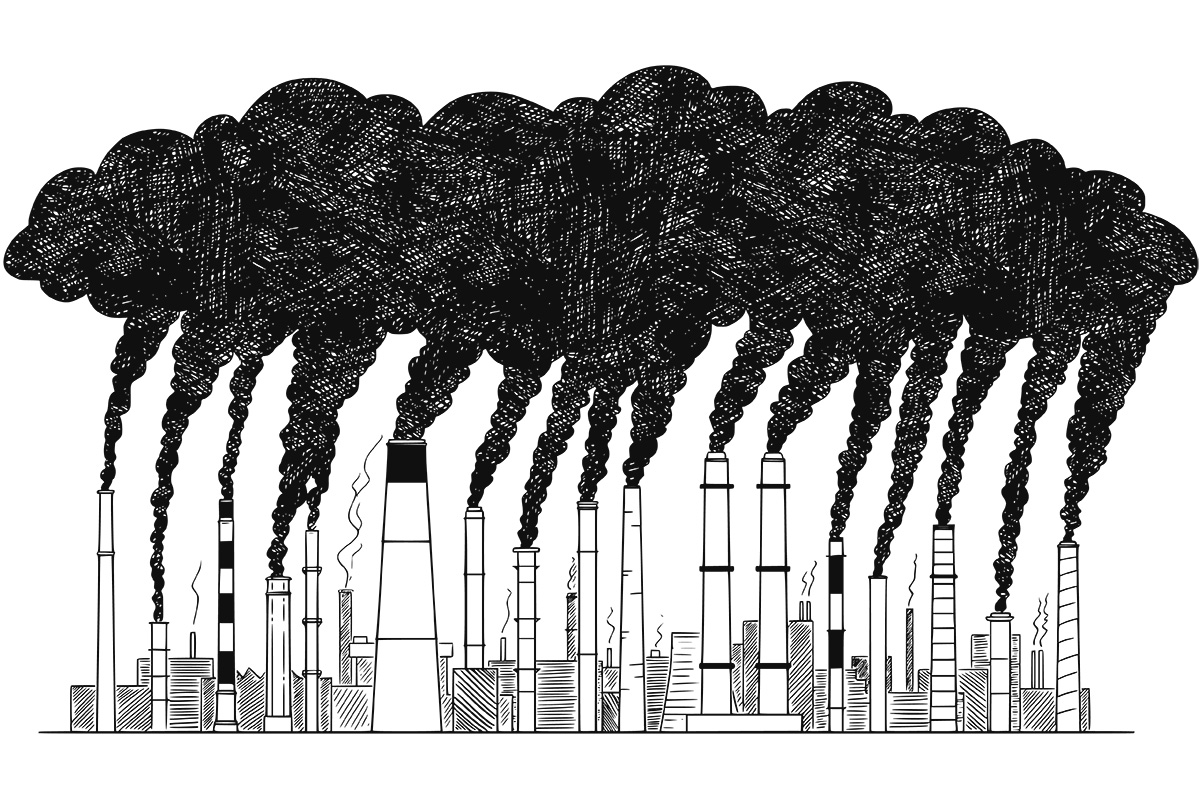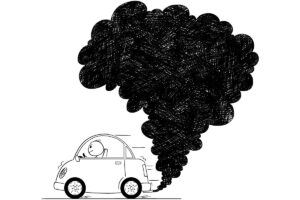Three decades ago, Eugene McCarthy, once a prominent Democratic presidential candidate, argued in The New Republic that a provision in the Clean Air Act of 1990 that would grant tradable permits to companies to emit a certain amount of sulfur dioxide was the modern equivalent of “indulgences” once sold by the Catholic Church. The comparison was not a compliment. The long-ago notion of indulgences was that those who made sufficient payments to the Church could be absolved of past sins or released from purgatory after death. In other words, the rich could literally buy their way into heaven. The practice was widespread and repellent enough by the early 1500s that it led to Martin Luther’s break from the Catholic Church and thus to the Protestant Reformation.
McCarthy drew a direct connection from indulgences to pollution permits. He noted that “the anticipation of credits for forgiveness of sin” had motivated William of Aquitaine to establish the monastery at Cluny in 910 so that monks could pray for the salvation of his army as it went about its work of “war, pillage, rapine, and other activities.” This same sentiment, McCarthy wrote, “perfectly echoed” the Clean Air Act’s stipulations that allowed a company to pollute in excess of its allotment, so long as it purchased credits from another that had reduced pollution elsewhere.
By equating pollution permits with war and plunder, McCarthy surely captured the views of a broader group of critics concerning market approaches to environmental protection. After all, the Democrat from Minnesota was a grand old man of American politics. Before running for president in 1968 and 1972, he served five terms in the House of Representatives and two in the Senate. (Perhaps unexpectedly, before the start of McCarthy’s political career, he was an instructor in economics at two Minnesota colleges in the 1940s.)
But economists have long held an alternative view of pollution. In 1890, the economist Alfred Marshall formulated the concept of “externalities,” in which pollution was not a sin akin to pillage and plunder, but instead was an undesirable result inflicted on others in the process of producing an otherwise desirable good or service. In 1920, A.C. Pigou—Marshall’s student and later his successor at Cambridge University—argued that an appropriate policy response to the externality of pollution was to impose a tax on the quantity of pollution emitted. The amount of this “Pigouvian tax,” as it came to be known, would depend on the level of harm from the pollution.
Thus, by the time of McCarthy’s 1990 essay, economists had for many decades readily accepted that pollution needed to be addressed, not as a sin to be denounced, but rather as a practical problem to be ameliorated in cost-effective ways. In keeping with this pragmatism, the amendments to the Clean Air Act critiqued by McCarthy became law in 1990 with the support of roughly 90 percent of Democrats and Republicans in Congress before being signed into law by President George H.W. Bush.
Today, not only do economists routinely consider pollution as an issue of tradable rights, but many environmental regulators—and environmentalists, too—have come around to a similar view. The property rights approach to pollution has led to prominent successes in many areas, and economists and policymakers continue to explore ways to implement these ideas to address a variety of environmental challenges.
Pollution in Terms of Property Rights
Throughout the 20th century, economists continued to refine how they thought about environmental protection. A classic 1960 essay by Ronald Coase, “The Problem of Social Cost,” further recast how economists thought about addressing pollution. In one famous example, Coase discussed the hypothetical situation of a railroad running beside a farmer’s field. Sparks from the train would sometimes start fires in the crops. How should this external cost—a kind of pollution “externality”—be addressed?
For non-economists, an obvious answer is for the government to pass a law. For example, the government might require that the railroad company install spark arrestors on the smokestacks of its locomotives, use a different blend of fuel or a new engine, leave a buffer zone beside the field, or relocate the rails altogether. Alternatively, the government might declare that the farmer should build a fence to protect the field, install a sprinkler system, change crops, leave a buffer zone, or perhaps even relocate the farm.
Coase argued that once property rights were clearly defined, then one party or the other would have an incentive to seek out the most cost-effective way of reducing this form of “pollution.”
Rather than viewing anti-pollution efforts in terms of how governments should choose which rule to impose, Coase took an altogether different approach. He pointed out that the problem could be rephrased in terms of property rights—in other words, who has what rights? For example, the government could say that the railroad company had a right to emit sparks, in which case the farmer would have to figure out the most cost-effective way of protecting the fields. Alternatively, the government could say that the farmer had a property right not to have sparks land among his crops, in which case the railroad would have to figure out an answer—which might include installing spark arrestors or other technology to prevent fires from occurring, or even just paying the farmer to put up with the annoyance.
In Coase’s approach, the question of how to respond to problems of pollution such as unwelcome railroad sparks did not need to be delegated to a government vote or board of experts. Nor did the problem of pollution, in Coase’s view, need to be solved by regulators imposing a Pigouvian tax to account for the “externality” imposed. After all, governments or any outside groups will inevitably possess much less detailed and hands-on information about the range of possible options—and how those options might be tweaked or combined—than railroads and farmers. Moreover, any choice of specific government regulations will be affected by politics and lobbying. Instead, Coase argued that once property rights were clearly defined, then one party or the other would have an incentive to seek out the most cost-effective way of reducing this form of “pollution.”
Of course, it is not readily apparent how to take this example with two parties—a railroad and a farmer—and transfer the key insights into, say, environmental problems involving air pollution emitted by many companies and affecting the broader public. As Coase acknowledged, the workability of this solution hinges on whether the costs of negotiating these pollution-reducing transactions are sufficiently low. Also, as Coase pointed out, although either party would have an incentive to seek out a cost-effective solution, how the property right was assigned would determine who paid the costs; in this example, it would determine whether the railroad or the farmer ended up paying.
But Coase’s essay planted a seed: His work emphasized that problems of pollution could be rephrased as questions of property rights. He also highlighted how efforts to reduce pollution might usefully focus on institutions that can reduce transaction costs to coordinate agreements between affected parties, as well as on the incentives created for individual actors in the economy to address environmental problems in flexible and creative ways.
Regulators Choose Flexibility
The non-economists and politicians who wrote the first major federal anti-pollution laws, such as the Clean Air Act of 1970 and the Federal Water Pollution Control Act of 1972, had a straightforward notion of how to proceed: They sought to give the newly created Environmental Protection Agency (EPA) the power to limit emissions of designated air and water pollutants. Economists refer to this as the “command-and-control” approach; for those who viewed pollution as a sin, such rules might be called “thou shalt nots.”
This original wave of environmental laws was clearly effective at reducing air and water pollution in the 1970s and 1980s. But as environmental regulators began to exercise their new powers, they soon recognized the value of flexibility in regulating the precise source of emissions in ways that reflected the key insights of economists concerning a rights-based approach to dealing with pollution.
The combination of flexibility from environmental regulators and Coasean insights from economists resulted in a number of success stories that demonstrate the benefits of using tradable pollution permits to address environmental concerns.
For example, imagine a large manufacturing plant with many smokestacks at different points in the production process. Should environmental regulators place inflexible limits on emissions from each smokestack? Or should regulators focus on the total emissions from the plant? After all, within a large company, it may be much cheaper and more effective to reduce emissions from one point source rather than others.
By 1974, the EPA began experimenting with “bubbles,” which focused on total emissions from each individual company. In effect, a company could carry out an internal trade. If a firm reduced emissions from some smokestacks by more than legally required, it could then reduce pollution from other smokestacks by less than would otherwise have been required—as long as total emissions from the firm met the legal limit.
An obvious follow-up question loomed: Should environmental laws place inflexible limits on emissions from a single firm? Or should the focus be on the overall quality of air or water in a certain geographic area? The 1977 amendments to the Clean Air Act allowed “netting,” in which firms that found ways to reduce emissions by more than the legally required amount received credits that could be sold to other firms in the same area—as long as the overall exposure to air pollutants for people in that area was reduced as planned.
Under these arrangements, firms that found ways to reduce pollution faster and further benefited internally from greater flexibility in adjusting to stricter environmental standards and externally by being able to sell excess pollution credits. Moreover, firms had strong incentives to discover innovative methods and new technologies to reduce pollution, which in turn often demonstrated how other firms could reduce pollution too.
The combination of flexibility from environmental regulators and Coasean insights from economists resulted in a number of success stories that demonstrate the benefits of using tradable pollution permits to address environmental concerns.
In one prominent example, the EPA began setting command-and-control rules in 1979 that required oil refineries to reduce the amount of lead in gasoline. Political finagling meant that the rules were less stringent for small oil refineries than they were for bigger ones—even though the health effects of lead in the air don’t vary based on its source. However, even with special allowances, the smaller refineries were struggling to comply.
The EPA sought to meet the overall goal of reducing lead pollution without driving many small oil refineries out of business. In 1982, the agency allowed oil refineries to earn credits if they could reduce lead emissions by more than was required. These credits could then be traded to refineries that were lagging behind. In 1985, the EPA further allowed refineries to “bank” credits, so they could save them for their own future use. By the mid-1980s, about 60 percent of the lead in gasoline was associated with these traded credits. Unsurprisingly—at least in retrospect—the induced innovations allowed lead to be phased out of gasoline more quickly and at a cost estimated to be 20 percent lower than would have occurred with an approach that did not allow for banking and trading.
Eugene McCarthy seemed to view his particular bugaboo—the sulfur dioxide trading program established by the 1990 revisions to the Clean Air Act—as simply a method for big companies to buy their way out of complying with environmental rules. Actually, the program facilitated a sharp decline in sulfur dioxide emissions, as economists Richard Schmalensee and Robert N. Stavins recently reported. “The program performed well,” they wrote in 2019, “with SO2 emissions from electric power plants decreasing 36 percent between 1990 and 2004, even though electricity generation from coal-fired power plants increased 25 percent over the same period.” They noted that the program also reduced emissions more cheaply than expected: “[C]ost savings overall were eventually at least 15 percent and perhaps as great as 90 percent of the costs of various alternative command-and-control policies.”
Emissions trading programs are now being used to reduce water pollution as well. In the Long Island Sound Nitrogen Credit Exchange, for example, about 80 local sewage-treatment plants in Connecticut and New York trade permits for reducing nitrogen emissions. There are three active trading programs being run across the six states in the Chesapeake Bay region to reduce emission of nitrogen, phosphorus, and sediment to rivers and streams. A trading program for reducing phosphorus emissions in the Minnesota River Basin program involves about four dozen sewage treatment plants and industrial sources.
Challenges and Opportunities
Once you begin thinking about property rights approaches to mitigating environmental harms, other applications leap readily to mind. From marine fisheries and rivers to public U.S. rangelands and endangered African species, rights-based approaches to managing environmental and natural resources have proliferated in recent decades.
Yet in any current discussion of environmental issues, finding ways to limit emissions of carbon dioxide and other greenhouse gases is the elephant in the room. Among economists, there has been an ongoing debate over whether marketable permits or a Pigouvian tax on carbon emissions is a more effective approach. For example, one advantage of issuing marketable permits is that they set a total quantity of emissions that can be scaled down over time.
But a working system of tradable carbon permits raises difficult questions, too. Would it allow trades across different greenhouse gases, between, say, carbon dioxide, methane, and perfluorocarbons? Would the market include carbon “offsets,” like planting additional trees or investing in renewable energy? Would pollution permits be granted to existing emitters at no cost, auctioned off, or some mixture of the two? Would a carbon-trading plan allow international trades, which might imply large payments from U.S. and European firms to reduce carbon emissions in China and India? Is it possible to apply Coasean insights to address carbon emissions across national boundaries, where property rights are often ill-defined and the transaction costs of negotiating among affected parties can be too high?
Our limited experience with tradable pollution permits for carbon has highlighted these and other political and practical hurdles. In June 2009, lest we forget, the U.S. House of Representatives passed the American Clean Energy and Security Act, which included a trading system to cut carbon dioxide emissions. The plan was to phase down the quantity of permits for carbon emissions over time, which likely would have meant higher prices for carbon-intensive sources of energy. Yet the legislation faced strong opposition from coal-producing states and those who characterized it as a backdoor energy tax, and it never came to a vote in the Senate.
Both the European Union (in 2005) and California (in 2006) have set up carbon trading markets, but with limited success. In California, a variety of challenges hindered the effort: Other regulations sought to reduce carbon emissions, and electrical utilities responded by increasing the amount of power they purchased from outside the state, where the emissions would not count against the California limit. Furthermore, a couple of years after the market was established, carbon emissions slumped when the Great Recession hit. The result was a large quantity of carbon permits relative to demand, causing the price of permits to fall so low that the market had little to no effect on reducing emissions.
Similar issues arose in Europe. Again, other regulatory policies simultaneously sought to reduce carbon emissions. Firms could cut their European carbon emissions by importing energy-intensive goods from outside the region, and they were also allowed to pay for carbon “offsets” that occurred outside Europe. For political reasons, E.U. carbon trading included the energy industry but not the transportation, commercial, or residential sectors. The E.U. policy has evolved through three main phases and many more rule changes. From 2013 to 2017, the price of buying E.U. carbon permits was so low that it had no significant effect in reducing emissions.
The practical questions of how to design pollution permit markets for carbon and other greenhouse emissions are not unanswerable, but they are clearly challenging. They offer a reminder that the Coasean vision of addressing pollution through an allocation of property rights relies on establishing stable markets with clear rules and reasonably low transaction costs.
From Indulgences to Incentives
Attitudes toward tradable pollution permits have evolved considerably in the three decades since McCarthy likened them to religious indulgences. Many environmental groups who were once skeptical about such proposals have since become firm supporters. Countries around the world with a range of ideological predispositions have been experimenting with this approach. As one recent example, China plans to have a carbon emissions trading system up and running by the end of 2020.
The property rights embodied in pollution permits provide an incentive for firms closest to the source of the pollution to think carefully and innovatively about how to reduce it.
Marketable pollution permits have attracted broad support for good reason: In many contexts, the policy has demonstrably worked. The property rights embodied in pollution permits provide an incentive for firms closest to the source of the pollution to think carefully and innovatively about how to reduce it. Trading these pollution permits in markets creates a flexible institution that improves environmental quality more quickly and at lower cost.






